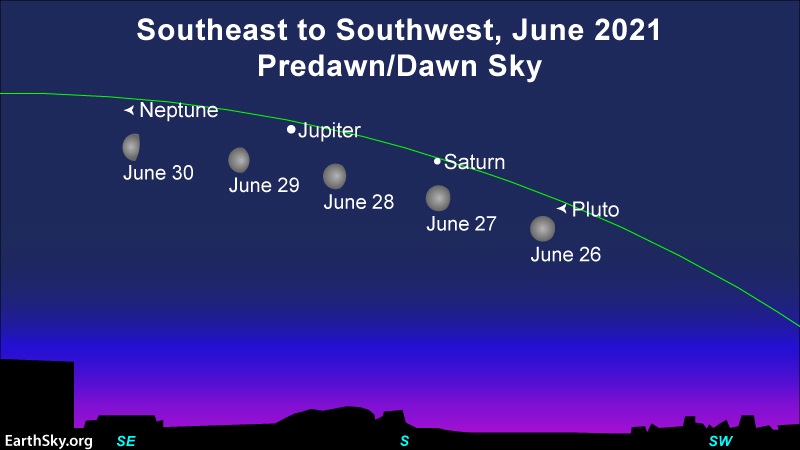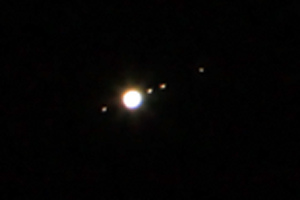
Moon, Jupiter, Saturn late night to dawn
On the last nights of June 2021, watch for three worlds in space: the moon, Jupiter, Saturn. The waning gibbous moon is past full on these nights. It’s rising later in the evening or after midnight. On June 25, Saturn follows the moon into the sky by roughly an hour. Jupiter follows an hour or so after Saturn. But the moon is moving, always, toward the east in orbit around Earth. As a result, the moon rises an average of 50 minutes later each night. So the moon catches up to Saturn and then Jupiter. On the night of June 26 (morning of June 27), the moon is near Saturn in the sky. By the night of June 27, the moon rises between Jupiter and Saturn.
And so it goes, as the evenings pass, with the moon shifting constantly toward the east.
The gas giant planets, Jupiter and Saturn, are bright. They’re easy to view with the eye alone, but you have to stay up late, or get up early. By the hour before sunrise on all of these nights, Earth will have turned under the sky … so that the moon and planets appear higher in your sky.
The moon and Jupiter, in particular, are so bright that you can’t mistake them for anything else. Saturn is fainter, but noticeably steady and golden in color. Plus, you can find Saturn in relationship to Jupiter and the moon.
For the fun of it, on the sky chart above, we show the solar system’s most distant known major planet, Neptune. And we mark the location of the dwarf planet Pluto. However, neither Neptune nor Pluto is visible to the unaided eye.
Moonrise and moonset calculator for the U.S. and Canada via Old Farmer’s Almanac
Moonrise and moonset calculator worldwide via timeanddate.com

Jupiter, the king planet
Jupiter is especially dazzling and hard to miss. It beams as the brightest starlike object in the morning sky! Jupiter ranks as the fourth-brightest celestial body to adorn the sky, after the sun, moon and planet Venus. Venus is in the west after sunset now and sets not long behind the sun. So you can’t confuse Venus for Jupiter, or vice versa.
Rising times of Saturn and Jupiter in the U.S. and Canada via Old Farmer’s Almanac
Rising times of Saturn and Jupiter worldwide via timeanddate.com
Ringed planet Saturn
The ringed planet Saturn pales next to Jupiter, with Jupiter outshining Saturn by some 16 times. Nonetheless, Saturn is easily as bright as a 1st-magnitude star. For the rest of this year, look first for blazing Jupiter and then seek out nearby Saturn.
By “nearby” we mean these two worlds are relatively close together on the sky’s dome. They are not particularly close together in space. Saturn is roughly twice Jupiter’s distance, as measured from Earth or the sun. Astronomers often give the distances of solar system bodies in terms of the astronomical unit (AU). One astronomical unit = sun/Earth distance of about 93 million miles (150 million km). At present, Jupiter and Saturn are about 5 AU and 10 AU from the sun, respectively.
Find out the present distances of the planets from Earth and the sun via Heavens-Above.
Moon, Jupiter, Saturn in the telescope
Novice at the telescope? If so, the moon, Jupiter and Saturn present exceptionally fine targets. Even with a modest backyard scope, these solar system bodies offer the most delectable eye candy.
It’s quite exciting to explore the lunar terrain along the lunar terminator – the dividing line between the lunar day and lunar night – where you have your best three-dimensional views of the lunar mountains, craters and lowlands. If you don’t have a filter, it might be better to observe the moon in a twilight or daytime sky, when the lunar glare is not so overwhelming.
Read more: Here’s how to see Jupiter’s 4 largest moons
Jupiter’s moons
Jupiter’s four major moons – Io, Europa, Ganymede and Callisto – are easy to observe with small telescopes. Thus these moons have found their way into history.
For example, early astronomers knew that Jupiter must be a massive planet. They knew it because Jupiter’s moons move so quickly in orbit. Here’s what you need to calculate mass. You need to observe a moon’s orbital period. Then you need to observe the moon’s mean distance from Jupiter (its semi-major axis). From there, it’s possible to calculate Jupiter’s mass.
Read more: How do astronomers know Jupiter’s mass?
Jupiter played a role in Earth history, too. The explorer Captain James Cook (1728-1779) used these moons to determine longitude at various coastal locations as he traveled around the world. This method of determining longitude would work only on land, not on the rough seas. But, then, using Jupiter’s moons to determine longitude on land provided a good double-check for the accuracy of the chronometer.

Saturn’s rings
Few sights match the grandeur of Saturn’s glorious rings. Although all the outer planets of the solar system (Jupiter, Saturn, Uranus and Neptune) have rings, the Saturn ring system is in a class by itself.

Jupiter and Saturn’s oppositions
If you’re not a night owl or an early bird, wait for a month. By early August, Saturn will be opposite the sun, rising in the east when the sun sets in the west. Astronomers call this an opposition of Saturn. Saturn’s opposition comes on August 2, and Jupiter’s opposition comes on August 20.
Opposition marks the middle of the best time of year to see a planet. Start watching Jupiter and Saturn now, and enjoy them over the next few months!
Bottom line: If you’re a night owl – or an early bird – let the moon show you the bright planets Jupiter and Saturn in late June 2021.











